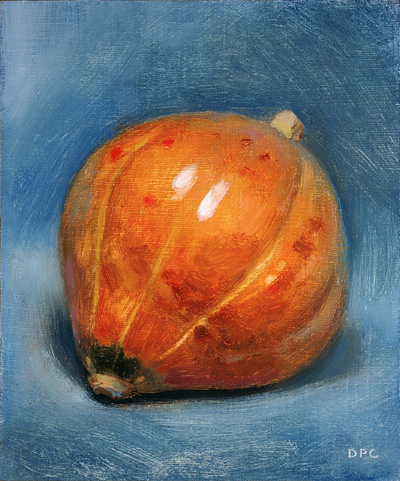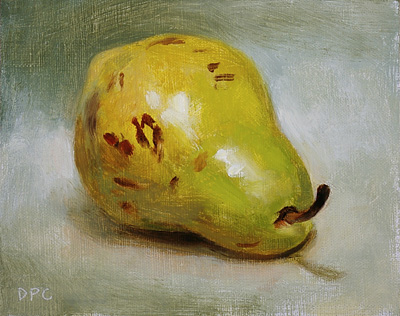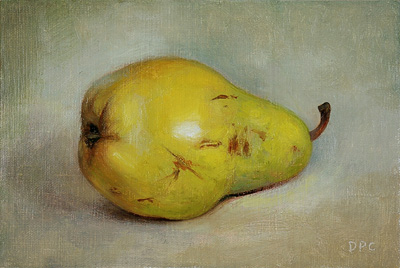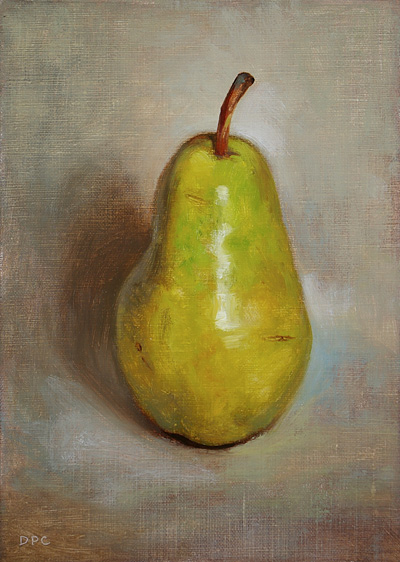
12/7: Golden Hubbard squash #2, oil on linen panel, 6x4.5 in.
This was a compositional challenge as I was stuck with a panel of the wrong format. I think it works though, tight as it is. I had some fun with the colors - I don't use crimson much, especially in large areas, and it's refreshing to kind of bathe in it like this. This is sketchier and not as solid as yesterday's, but the thing that really bothers me is that I gave too much contrast to the little hole in the stem.
Saturday, December 8, 2007
Golden Hubbard squash #2
Posted by
Dan P. Carr
at
11:39 PM
2
comments
![]()
Tags: daily painting, food
Friday, December 7, 2007
Golden Hubbard squash

12/6: Golden Hubbard squash, oil on linen panel, 6x5 in.
My wife and I both doubted the sticker on this which said it was a Hubbard, thinking instead it had to be an ambercup or some other pumpkin-like variety. But there is a variety of Hubbard squash that is smallish and gold and not blue or green, though most pictures online show the skin being very warty; and of course the people who'd put the sticker on this thing in the first place would know what they had. Whatever it is, it's great - and I felt I struck a coup this time (at least in the beginning) when I reached a magic balance of opacity and transparency, and the edge transitions began to really define the space. Some of this ideal quality I lost, as invariably happens, but some I found again and pushed further, so in the end I'm quite pleased with it.
Posted by
Dan P. Carr
at
7:06 PM
0
comments
![]()
Tags: daily painting, food
Thursday, December 6, 2007
Bartlett pear #3

12/5: Bartlett pear #3, oil on linen panel, 4x5 in. SOLD
I've been letting down the two or three people who care, by not mentioning how long some of these pieces have taken. This one was about 45 minutes. (I think the one before was more like an hour and a half.) The yellows and greens of these pears are annoyingly much more vivid than I can paint, but I hope I've been getting some sense of them. To me this one is a little better, as I think I'm getting back some of my own vividness and clarity of color which had been a little more tepid lately.
Old English word of the day:
pere [pĕr'-ə]: pear.
(perewós: perry, a cider-like drink made from pears; literally "pear moisture/juice.")
From a history of pears and perry in the UK, by Gillian Grafton:
Tacitus implies in some of his writings that pears were cultivated in Britain at the time of the Roman occupation. Charlemagne (circa 800) issued a list of plants to be cultivated which included pears. In Britain however, definite records are not available until after the Norman Conquest. The Domesday Book of 1086 mentions old pear trees several times as boundary markers, implying their cultivation before this period.
Court accounts in the reign of Henry III (1207-72) show that pears were imported from France and for many years French varieties dominated English orchards. Pears were imported from the La Rochelle area of France which was famed for its pears.
Eleanor of Provence, wife of Henry III, developed extensive orchards and there is a record in 1262 of the court gardener planting six Cailhou (Cailloel) pear trees. Eleanor of Castille, wife of Edward I, was a keen gardener. In the court accounts for 1276-92 the following pear types were noted: Kaylewell (Calswel); Rewel (de Regula); and Pesse-Pucelle. Kaylewell was a synonym for the Caillou and was seen as a pear fit only for baking but was very popular with the royal family at the time. Other pear varieties noted at this time were: Martins; Dreyes; Sorells; Gold-Knopes; Regul; and Chyrfall.
Sometime before 1388 the first important English pear variety, the Wardon, was introduced by Cistercian Monks at Wardon in Bedfordshire. It was widely used for pies, which became known
as Wardon pies.
Posted by
Dan P. Carr
at
2:04 PM
0
comments
![]()
Tags: daily painting, food, history, miscellanea, Old English, words
Wednesday, December 5, 2007
Bartlett pear #2

12/4: Bartlett pear #2, oil on linen panel, 4x6 in.
My painting of the light has been different lately even after I went back to painting on the easel, and I'm not sure why. Sort of blotchy and all over the place like Renoir, but without the greasy stringiness. I think he's the one I was thinking of. I never liked Renoir - but if someone else would say this has kind of a Renoir feel I'll take it as a compliment.
Posted by
Dan P. Carr
at
11:54 PM
0
comments
![]()
Tags: daily painting, food
Tuesday, December 4, 2007
Bartlett pear

12/4: Bartlett pear, oil on linen panel, 7x5 in.
I'm still here. I was going to post something about the Paint Out but was too tired after the reception, and on Sunday night had some kind of stomach bug that still had me feeling weak yesterday. (Maybe it was just real bad indigestion, made worse by my ignoring my wife's advice to lay off dairy and other stuff for a while.) Anyway, I haven't been at the computer much and haven't responded to anyone, but thanks to those who wished me luck the other day. I struggled at the Paint Out, as I will write about later, but I'm proud of myself for taking part and it only made me want to do more plein air work. Nevertheless I'm really glad to be back at my chunky easel, and for now there will be more small fruit.
Lately I started making my panels using Yarka extra fine grain linen glued to hardboard with a liquid hide glue, spread with a brush or roller. There are a few more irregularities in the linen than the Old Holland brand I was using at first, and the priming is stiffer. But I love its funky sizing smell, and the feel and look of it being made by hand, like they just sliced a length of it off in their cold Russian workshop and mailed it to you. I don't know how this brand compares to a roll of Claessens, but I read that it was a great value and it really is. So far I haven't had much trouble with the linen being slick - maybe I am working better and am more in tune with the surface.
Posted by
Dan P. Carr
at
2:08 PM
0
comments
![]()
Tags: daily life, daily painting, food, materials, miscellanea


